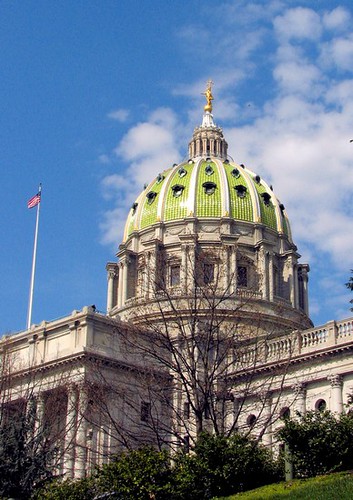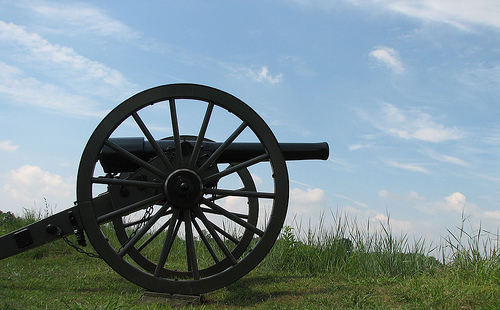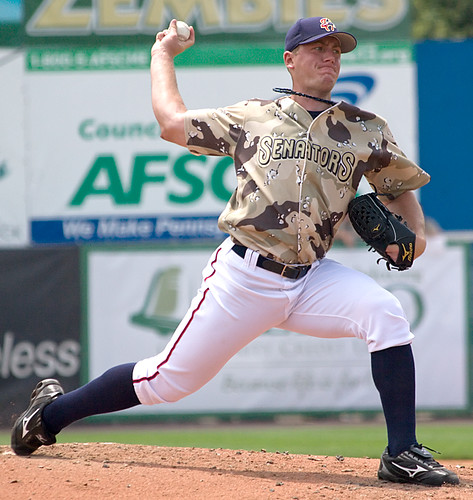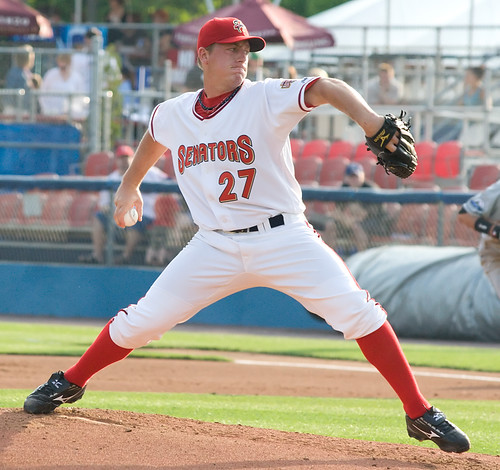
Back in June 2008, Negro Leaguers were drafted in a pre-draft ceremony; a tribute formulated by MLB Great and Hall-of-Famer, Dave Winfield and was embraced by Major League Baseball. This was Winfield’s way of keeping the memory and dreams of Buck O’Neil alive.
Bobo Henderson realized the significance of the day.
"It's just like being born again," Henderson said on Thursday as he sat waiting for what had been decades in coming.
Finally, Henderson, a shortstop and outfielder with the Kansas City Monarchs, and 29 others from Negro Leagues' yesteryears were welcomed into the family of Major League Baseball.
It was a day Henderson won't forget.
Nor will the people behind the idea.
"I've often said Jackie Robinson coming to the big leagues was baseball proudest moment," Commissioner Bud Selig said. "Therefore, the recognition of all these people who played a role in that day, should have been recognized and, in many cases, should have been playing in Major League Baseball, I'm proud of that."
Selig, Hall of Famer Dave Winfield and Jimmie Solomon, baseball's executive vice president, devised a strategy for the special Negro Leagues Draft.
Credit for the Draft goes to Winfield, who envisioned it serving as a bridge between baseball's past and its present."It's a wonderful day," said Winfield, now a vice president with the Padres.
The event served as a prelude to 2008 First-Year Player Draft. Every team in Major League Baseball selected a player whose career encompassed the Negro Leagues.
BaseballChannel.TV streamed the Negro Leagues Draft live in front of several hundred people at The Milk House at Disney's Wide World of Sports Complex.
The fans here saw Major League Baseball tie up some of its loose ends, and were brought face to face with living baseball history.
The living history was embodied in men like Emilio "Millito" Navarro, whom the Yankees drafted. Navarro, now 102, is the oldest living professional ballplayer. The living history was embodied in Mamie "Peanut" Johnson (Nationals), one of a handful of African-American women to play professional baseball.
Who knows what they might have achieved had baseball's doors been open to them? But baseball opened those doors on Thursday, even if belatedly. Yet none of the draftees looked at it as anything other than a tribute.
"I was glad that they picked me for the Atlanta area," said Red Moore, a smooth-fielding first baseman for the Atlanta Black Crackers, Baltimore Elite Giants and the Newark Eagles.
Moore thanked Selig for this day.
But Selig, as did Winfield, didn't want the spotlight on him."It's not about me," Selig said. "It's about baseball as an institution and it's about them. I'm proud that we were really able to recognize them for what they've done."
The Negro Leagues Draft was a continuation of baseball's effort to fix a historical wrong.
In the past, baseball has used other initiatives to right the wrong:
• The Commissioner's Office provided the money for a research project that led to the induction of 17 Negro Leagues ballplayers and executives into the National Baseball Hall of Fame in 2006.
• Major League Baseball has partnered with the Negro Leagues Baseball Museum in Kansas City on several projects, including fundraisers for educational programs.
• Baseball has organized the Civil Rights Game as a tribute to the role the sport has played as a social force in America.
Until Thursday, the game hadn't welcomed the few surviving links to Robinson, Larry Doby, Leon Day, Satchel Paige, Rube Foster, Martin Dihigo, Oscar Charleston, Josh Gibson and Cool Papa Bell into its family.
At the Disney sports complex, baseball did. It showed Henderson (Angels), Moore, Joe B. Scott (Brewers), "Mule" Miles (Mariners), "Lefty" Bell (Twins) and Mack "The Knife" Pride (Rockies) that they belong.
They were all under the Major League spotlight at the Disney complex, if only for this day.
"It brought us exactly full circle, because it was something we had always hoped for," said Henderson, who lives in San Diego. "It's just like Martin Luther King always said:' One day -- one day -- there's gonna be a white boy and a black boy holding hands together.'
"That is this day."
Complete list of Negro League players Drafted:
Los Angeles Angels of Anaheim: Neale "Bobo" Henderson, SS, Kansas City
Henderson was a product of the San Diego school system where he polished his talents well enough that he could think about continuing to pursue the game. In 1949, Henderson signed with the Monarchs, a team he played with for one season as primarily an outfielder. But he also was a solid infielder, often playing shortstop. Henderson later played for a traveling team that Negro Leagues legend Cool Papa Bell managed.
Baltimore Orioles: Bert Simmons, P/OF, Baltimore Elite Giants
Simmons, a World War II veteran who played college ball at North Carolina A&T, spent nine seasons in various lesser leagues before joining the Elite Giants in 1950. While with the Elite Giants, he and his teammates once played in the historic Polo Grounds to a reported crowd of 50,000 people. After he retired in '52, Simmons coached Little League, American Legion, high school and college baseball for more than 40 years.
Boston Red Sox: Jim Colzie, P, Indianapolis Clowns, Atlanta Black Crackers
A pitcher for seven years, Georgia native Jim Colzie characterizes his finest career moment as the time he beat future Hall of Famer Satchel Paige in 1947. After his retirement from playing professionally, Colzie spent two decades working with Little Leaguers and umpiring in semi-pro leagues, all while working as a junior high history and math teacher.
Chicago White Sox: Hank Presswood, SS/3B, Cleveland Buckeyes, Kansas City Monarchs
A native of Mississippi, he broke into the Negro Leagues in '48, a season after Jackie Robinson, Larry Doby, Willard Brown and two others had integrated the Major Leagues. In his three seasons with the Buckeyes, Presswood played mostly shortstop, hitting a Mendoza-like .198 as a rookie, but his numbers improved over time. With the Buck O'Neil-coached Monarchs, he played third.
Cleveland Indians: Otha "Li'l Catch" Bailey, C, Chattanooga, Cleveland, Houston/New Orleans, Birmingham
The nickname "Li'l Catch" fit Bailey, a pint-sized catcher with good speed but no power. He broke into the Negro Leagues in 1950 when he was 20, and Bailey, a scrappy ballplayer, prided himself on calling a good game. He stayed with various teams until '59.
Detroit Tigers: Cecil Kaiser, P/1B/OF, Homestead, Pittsburgh
Kaiser was the quintessential barnstormer. He bounced around baseball, playing ball in Puerto Rico, Mexico, Cuba, Panama and the Dominican. In five seasons in the Negro Leagues, Kaiser was a pitcher who mixed a fastball with offspeed stuff. He was the typical crafty left-hander, surviving with his control. He produced a dominating 1949-'50 season in the Puerto Rican League.
Kansas City Royals: Ulysses Hollimon, P, Birmingham, Baltimore
Hollimon played for various Negro League teams from 1948 to 1956. In 1951, he pitched in the East-West All-Star Game in Comiskey Park, an event that routinely drew large crowds of black fans. Nicknamed "Slim," he attended Tennessee A&I College and coached Little League baseball after his playing days.
Minnesota Twins: Bill "Lefty" Bell, P, Kansas City Monarchs, Birmingham Black Barons
Bell, renowned for his ability to work the corners of the plate, joined the Monarchs in '49, as the Negro Leagues were transitioning from a major force in baseball to a lesser renowned league.
New York Yankees: Emilio "Millito" Navarro, SS/2B/3B, Cuban StarsHe might have been one of the first athletes whose nickname sufficed. Millito was a superstar in his homeland of Puerto Rico. A versatile infielder, he could play anywhere, flashing good hands wherever he played. But he was more than a good field/no hit player, which is why he's enshrined in the Puerto Rican Hall of Fame. Millito, 102, is the oldest surviving professional player and the first Puerto Rican to play in the Negro Leagues.
Oakland Athletics: Irvin Castille, SS, Birmingham Black Barons
Castille, who now lives in Los Angeles, played shortstop for Birmingham in the 1951-53 seasons. He signed autographs and shared stories about his playing days at the Times of Greatness Mobile Museum in Chicago last June.
Seattle Mariners: John "Mule" Miles, 3B/OF, Chicago American Giants
Legendary manager Candy Jim Taylor pinned the nickname "Mule" on Miles, a power hitter who was noted for his long homers. Miles wasn't known for his speed, but he could cover a decent amount of ground in the outfield, and he could throw. He was more a Dave Kingman-type slugger: a home run or nothing.
Tampa Bay Rays: Walter Lee Gibbons, P, Philadelphia, NY Black Yankees, Indianapolis
Gibbons began playing sandlot ball when he was 8 with the Pepsi-Cola Juniors. He broke into the Negro Leagues with the Stars in 1941. He split the season with the Stars and the Black Yankees, compiling few innings and losing his only decision. After World War II, the barnstorming Clowns saw Gibbons playing in Tampa and signed him in 1948. He played two seasons with the team, and then went to play in Canada, along with the Dakota League before entering the military for the Korean War. Gibbons returned to baseball after the war and played in a lesser league in North Dakota.
Texas Rangers: Charley Pride, P, Memphis Red Sox, Birmingham Black Barons
Later a star of country music, Pride had more than a fair amount of success playing professional baseball in the 1950s. Found on the sandlots in Memphis, he never became the star in baseball that he became in music. Pride, a right-hander hurler, was noted for his sharp curveball. He also went to camp with the New York Mets and the Milwaukee Brewers and routinely worked out with the Texas Rangers after he hit it big in music. He once served as the Rangers' designated pinch-hitter in a Spring Training game, going 1-for-2 vs. Hall of Famer Jim Palmer.
Toronto Blue Jays: Harold Gould, P, Philadelphia Stars
Gould, a right-hander, got his start playing in 1942 for Gouldtown, a town in New Jersey named for one of Gould's family members. He joined the Stars in 1946 and stayed with the ballclub through the 1946 season, the year before Jackie Robinson integrated the Major Leagues. Gould then played for a couple of lesser leagues before leaving the game behind.
Arizona Diamondbacks: Bob Mitchell, P, Kansas City MonarchsHe had a brief career with the Monarchs in the 1950s, as the league wound to its end. But Mitchell, a Tampa native, became an advocate for those men whose careers in the Negro Leagues didn't pave the way for inclusion into organized baseball.
Atlanta Braves: James "Red" Moore, 1B, Atlanta, Baltimore, Newark
Moore, a slick-fielding Atlanta native, had one of the best gloves of any first baseman in the history of black baseball. During his career, he played alongside Hall of Famers Willie Wells, Ray Dandridge and Mule Suttles at various times. Few players had Moore's gift for the flash. His pregame routines treated fans to the kind of entertainment that drew laughter. Unfortunately, his bat didn't match his glove work.
Chicago Cubs: Walt Owens, P/1B, Detroit Stars
A native Clevelander, Owens played for the Stars from 1953-'55. At the time, he was attending Western Michigan University, where he picked up a bachelor and master's degree. He went on to teach in the Detroit Public Schools and at Northern Illinois, where he coached the baseball and basketball teams.
Cincinnati Reds: Charlie Davis, P, Memphis Red Sox
Nicknamed "Whip," Davis managed the Rockdale Rawhides in the late 1950s after he stopped playing for the Redbirds. Upon leaving baseball altogether, Davis spent three decades working as heavy equipment operator. He owns a shop where he rebuilds older cars.
Colorado Rockies: Mack "Mack the Knife" Pride Jr., P, Memphis Red Sox, Kansas City Monarchs
Pride spent two seasons in the Negro Leagues from 1955 to 1956. He later coached Little League baseball, as well as having an active role in ministry.
Florida Marlins: Enrique Maroto, P, Kansas City Monarchs
Maroto carved out a professional career in leagues throughout Latin America and the United States. A 5-foot-9, 150-pound left-hander, he spent two seasons with the Monarchs in 1954-'55, as the impact of the Negro Leagues waned. He also played in his native Cuba. The Cardinals and Senators both signed him to contracts, but he never reached the bigs.
Houston Astros: Bill Blair, P, Detroit Stars, Indianapolis Clowns
Blair didn't have a long career in black baseball. He left the game and has been running black newspapers in the Dallas area with his sons. Blair, a World War II vet who attended Prairie View A&M, played for the Clowns and for other Negro League teams from 1946-'51. Blair, who pitched a no-hitter in the Denver Post Tournament, toured with Jesse Owens and the Harlem Globetrotters.
Los Angeles Dodgers: Andrew Porter, P, Baltimore, Louisville, Cleveland, Newark, and Indianapolis
His nickname was "Pullman," and the powerful Porter worked as hard as a Pullman porter. Noted for throwing smoke, he became one of the linchpins in the 1930s of an Elite Giants rotation that featured Bill Byrd and Jonas Gaines, legendary pitchers from black baseball. Porter, who played in Cuba, Mexico and Venezuela, played in the Negro League East-West All-Star Game in 1932 and 1950. He is second oldest Negro Leaguer and one of the few who barnstormed against Major Leaguers. In his later baseball days, he played for the first all-black team in organized baseball (Porterville Comets in 1952).
Milwaukee Brewers: Joseph B. Scott, OF/1B, NY Black Yankees, Memphis Red Sox
Scott was a hustling outfielder who broke into the Negro Leagues while talent like Monte Irvin, Josh Gibson, Cool Papa Bell and Satchel Paige still toiled in the league. A leadoff hitter, Scott had a reputation as a hustling ballplayer on some solid Memphis teams. In a historical footnote, he played at Wrigley Field on a high school team in Chicago, earning the distinction as the first black to play at Wrigley.
New York Mets: Robert Scott, P/1B, NY Black Yankees, Memphis Red Sox
A Georgia native, Scott spent five seasons in the Negro Leagues --1946-1950. In his last season, he barnstormed with the Jackie Robinson All-Stars. After leaving the sport, Scott was a union bricklayer for almost 40 years.
Philadelphia Phillies: Mahlon Duckett, 2B/3B, Philadelphia Stars, Homestead Grays
Duckett broke into the Negro Leagues in 1940 at the age of 17 with the Stars. In nine seasons with the Stars, he proved a versatile infielder with a slick glove but a lightweight bat. His bat never did develop much punch, particularly in the early '40s when the league boasted some of its brightest stars.
Pittsburgh Pirates: James Tillman, C, Homestead Grays, Charlotte
Tillman had the task of filling in for Josh Gibson -- but what player could ever take the place of the "Black Babe Ruth"? He played for the Grays, a powerhouse franchise that split its home games between Pittsburgh and Washington, D.C., from 1941-'43. He played for black teams in the D.C. area before joining the Grays.
St. Louis Cardinals: "Prince" Joe Henry, 2B/3B, Memphis, Detroit, Indianapolis/Detroit
When he broke in with Memphis in 1950, Henry saw black baseball in transition. Its best players had jumped to the Majors, but Henry still found solid competition in the Negro Leagues. During his career he hit well, but displayed little power. Henry also struck out a lot, which was somewhat unusual for a player like Henry. He later became one of the clown princes of the game, playing for Goose Tatum's Detroit Clowns. In recent years, Henry has written a column for The Riverfront Times in St. Louis.
San Diego Padres: Walter McCoy, P, Chicago American Giants, Kansas City Monarchs
McCoy, a sandlot star in San Diego, spent four seasons with the American Giants at Comiskey Park in the mid-1940s. A left-hander, he had decent success before moving to organized baseball. He played in various Minor Leagues and also in the Mexican League before giving up baseball in 1955.
San Francisco Giants: Carlos Manuel Santiago, 2B/SS, New York Cubans
On a barnstorming trip to the United States, Santiago caught the eye of John Beckwith, manager of the Atlanta Black Crackers in '45. He played half the season with Atlanta before jumping to the Cubans, where he played short and second. Two years later, he became the first black Puerto Rican to play organized baseball, signing with the Stamford Bombers in the Continental League. Santiago's signing created opportunities in the United States for Minnie Minoso, Roberto Clemente and other men with dark skin and Latino blood. In 1951, Bill Veeck invited Santiago to training camp with the Indians, but he didn't go. Uncle Sam drafted him and sent him to Korea. After he returned, he continued to play in various leagues in the United States and outside. His play in his homeland, Puerto Rico, earned Santiago induction into the country's Hall of Fame in 1993.
Washington Nationals: Mamie "Peanut" Johnson, P, Indianapolis Clowns
A right-handed pitcher of slight stature, Johnson threw as hard as some men. She didn't, however, have a long career in black baseball; she was one of the three women who suited up for the Clowns, a team Henry Aaron once played for. She signed with the ballclub in 1953 and played until 1955. Johnson won 33 games in her career.
Article courtesy of MLB:MLB honors Negro Leaguers in Draft
Complete list of players Drafted courtesy of MLB: Special Negro Leagues Draft; Team by Team
Read more...







































